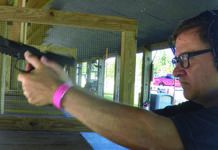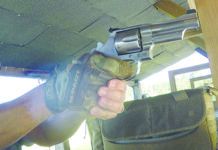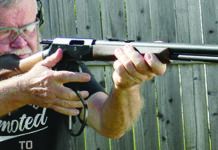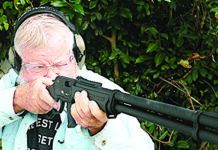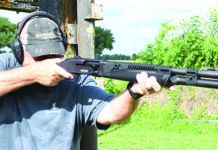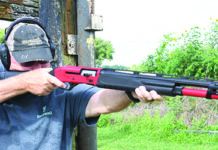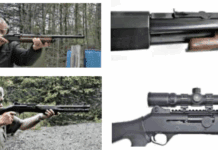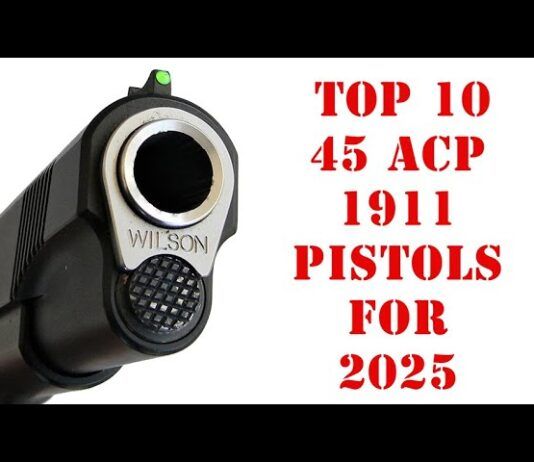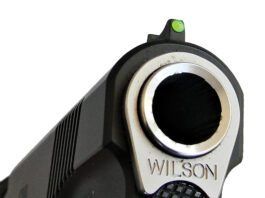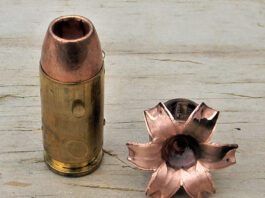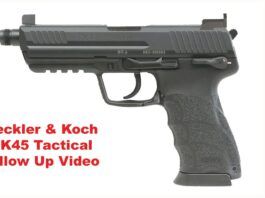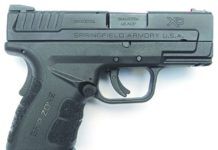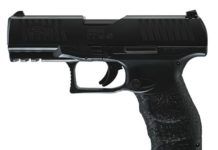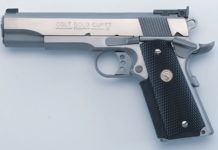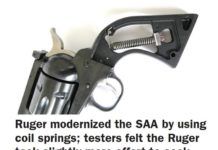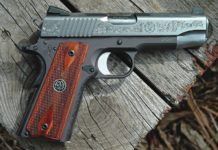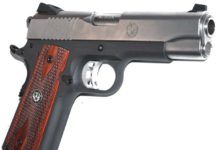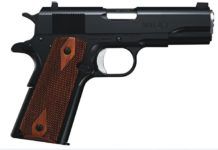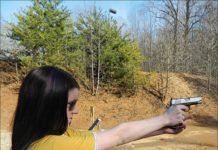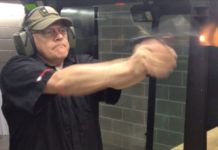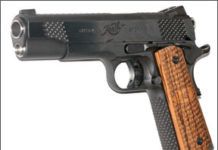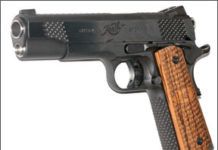Springfield Armory XD Mod.2 3.3-Inch SubCompact XDG9845BHCSP 45 ACP, $593
Springfield did more than just reduce the grip and barrel and slide length like they did with the XD 3-inch subcompact, which is another pistol we have given Buy It rating to in the past. With the Mod.2 series of pistols, Springfield addressed ergonomics in small pistols, which are usually difficult to shoot due to their small grips. Add in powerful rounds like 147-grain 9mms and 230-grain 45 ACP FMJs, and the shooter finds the pistols can easily move and shift in the grip, mainly because subcompacts do not have a lot of grip to hold onto in first place. We all know consistency is the key to better and more accurate shooting, and a good grip is the foundation of that concept. Springfield tackled this issue with the Grip Zone, or three different types of textures placed in strategic places. The three zones of texture provide different types of adhesion. Zone 1 texture is located on the frontstrap and backstrap and provides a good anti-slip surface. Zone 2 texture is the most aggressive and is located on the side panels. Zones 1 and 2 are a type of stippling that our team felt offers good adhesion without being uncomfortable to grip firmly. Zone 3 texture covers the remainder of the frame and has a slight pebble texture.
Walther Makes First 45 ACP Pistol
Walther's new PPQ in 45 ACP is the first true production Walther in that chambering in the company's history, Walther says. The gun is equipped with the Carl Walther quick defense trigger, traditional front and rear slide serrations, and ambidextrous controls like other PPQs. The PPQ 45 Auto will hit the market and be available in retail stores on October 1, 2015.
Cyndi Flannigan, Walther Arms' vice president of sales and marketing, says of the new pistol, "This new caliber and product offering is a benchmark for Walther and the PPQ. We have built it to the same exact German standards that have made this model so well received, and it is a superior choice for home defense and personal protection." We'll soon see about that.
1911 Target-Gun Shootout: MAC Bullseye Versus Colt Gold Cup
Although many 1911 shooters are concerned with personal defense, a market clearly exists for target-sighted 1911 handguns. Makers who offer a 1911 of any type often provide an upgraded target model for those wishing to use the pistol in competition. Many of these are a far cry from the old warhorse that fought in two World Wars and many skirmishes elsewhere. In this shoot-out, we have included a classic target-grade 1911, the Colt Gold Cup Trophy against a Metro Arms long-slide 1911 offered as a factory product in the extended version that many shooters appreciate. During the course of the test we learned something about accuracy and came away with respect for each handgun. But one handgun was clearly better and more practical for most shooters:
Convertible Flattops: Lipseys Blackhawk and New Frontier
Colt started to put adjustable sights on its single-action revolvers around 1890 to fill a need for target shooters. Most single actions of the day, and, in fact, to the present, feature simple fixed sights; a blade front and rear consisting of a groove milled along the top strap. These sights suffice for most shooters, though some Kentucky windage and elevation are required with some models that did not shoot to point of aim. Adjustable sights take out the guesswork since they can be adjusted to any load being fired. Colt named the single action with adjustable sights the Flattop Target Model, and these First Generation revolvers were shipped from 1888 to 1896 with fewer than 1,000 made. Obviously, they are quite rare. Bisley models were also offered as Flattop Target Models, and even fewer of these models were produced. What these first Flattop revolvers featured was a replaceable front-sight blade to adjust elevation and a rear sight that was drift-adjustable for windage. Since the rear sight groove was not needed, the top strap of the frame was machined, flat hence the name "Flattop."
The two flattops we tested recently were a used Third Generation Colt New Frontier and a new Lipsey's exclusive Ruger New Model Blackhawk. Both wore aftermarket grips, and from outward appearances, looked nearly identical. What piqued our interest in these two revolvers was they were also convertibles with an extra cylinder. One cylinder was chambered in 45 Colt (sometimes called Long Colt to ensure it doesn't get confused with a shortened pronunciation of Automatic Colt Pistol) and the other was chambered in 45 ACP. Both cartridges are very popular, and 45 ACP made these six-shooters compatible with ammo normally used in a semi-automatic pistol.
The operating systems of each revolver are what distinguish them. The New Frontier is an old-school single action with no built-in safety, so it must be carried with the hammer resting on an empty chamber to guard against discharges if dropped. The Ruger New Model Blackhawk incorporates a transfer-bar safety mechanism that allows the revolver to be carried with all chambers loaded. The Colt uses a flat mainspring and flat springs throughout, and the Ruger uses a coiled mainspring as well as coiled springs throughout.
We used a revolver range rod and rod head combo from Brownells in 45 Auto/45 Colt (080-617-045WB, $42) to check each chamber for alignment with the bore. We found no issues. Next we looked at headspace—the space between the recoil shield of the frame and the rear of the cylinder—and assumed all would be fine since the Ruger was new the Colt looked unused. Again, our assumption was confirmed with Clymer No-Go gauges from Brownells in 45 Auto (184-000-041WB, $60) and 45 Long Colt (184-100-511WB, $30). Both cylinders for both revolvers have non-rebated cylinders. The headspace check process was a bit different for each revolver. For the Colt, we put the hammer on half-cock and opened the loading gate; for the Ruger, we just had to open the loading gate and drop the No-Go gauge into a chamber. If correct, the gauge stops the cylinder's rotation. This was repeated with all 24 chambers;12 for both 45 Colt cylinders and 12 for the two 45 ACP cylinders. With the Colt, the No-Go gauge is removed only after removing the cylinder. The process is tedious, but it's warranted to ensure the safety of a used revolver. The Ruger has a reversing pawl, like Ruger's Vaquero models, so the process is quicker. So is unloading the Ruger, but we'll get to that. Finally, we checked the cylinder-to-barrel space, aka cylinder gap, using a Brownells feeler gauger (606-950-252WB, $28). The space should spec out between 0.004 to 0.006 inch. We found the dimension on the Colt was 0.007 inch for each cylinder. On the Ruger, the 45 Colt cylinder gap measured 0.005 inch and the 45 ACP cylinder was 0.006 inch.
With the pistols all checked out, we were then able to get to the fun part and begin shooting them. Here's how that went:
Upgrading Rugers Commander
Readers will recall our May 2015 test of Ruger's new SR1911 CMD-A, a Grade A lightweight Commander-style 45 auto. To sum up that test, we consider the new Ruger lightweight Commander-type auto to be one of the finest self-defense handguns available today. The gun has just what it needs and no extra nonsense. It has excellent sights. It does not have a firing-pin block, nor a full-length guide rod, which some of us despise. That means you can take the gun apart easily with no tools. The slim and attractive wood grips seem to be an aid to pointing the gun, and also contribute to concealment. We found the two-tone finish appealing, and the factory dehorning was mighty good. The original trigger pull was very much acceptable, as was the accuracy. The integral plunger housing cannot come loose. Finally, those with fat hands will like the full-size grip of the LW Ruger better than the shorter one on guns like the Colt CCO. It makes for a better grip, and speed reloading is easier.
But even good products like the CMD-A can be improved, so Senior Technical Editor Ray Ordorica bought it for himself with an eye toward making it resemble his Colt CCO. He slicked the Ruger up, included beveling the front of the frame, eliminating all the sharp edges around the ejection port, knocking the sharp bottom off the mainspring housing, removing metal from under the trigger guard to get the hand higher, checkering the front strap, and rounding the sharp edges at the sides of the grip safety. The steel parts were reblued as needed with Formula 44/40 Instant Gun Blue, and the aluminum parts were reblackened with Aluminum Black, both available from Brownells. And as the previous photo shows, he engraved the gun.
One of the main performance goals was to improve the Ruger's already good trigger pull, so he contacted master gunsmith Ned Christiansen at Michiguns and asked about getting a trigger job. Instead, Christiansen recommended we try an "ignition set" offered by John Harrison (HarrisonCustom.com). Harrison offers a complete line of gunsmithing services along with a not-quite-drop-in kit called the Harrison Custom HD-120-TR Extreme Service Ignition Package, Strut, and Trigger, $186. We chose the carbon-steel version in white, though the parts are also available with a black coating or of stainless-steel construction. At Harrison's suggestion, we opted for the True Radius sear, which has its contacting surface ground on an arc centered on the pivot pin. He also sent along a hammer strut and a replacement trigger a bit shorter than the Ruger's. Our task was to fit all the parts and see what dropped in and what did not, and of course evaluate the products. Here is what we found.
Tactical 1911 Pistol Shoot Out: SIG Sauer Vs. Smith & Wesson
The 1911 handgun has survived for more than one hundred years based on excellent ergonomics, great reliability, and its ability to chamber a fight-stopping cartridge. Modern 1911 handguns are much evolved from the Colt 1911 first issued to Army troops in 1911. However, a doughboy going to Europe in 1917 would be able to instantly load, make safe, fire and use a modern 1911 handgun. The ability of the platform to accept a weapon-mounted light was an inevitable part of the 1911's evolution, because a gun-mounted combat light is a good tactical addition. They allow for the identification of a threat, illumination of an area, and make fail-safe identification possible.
Two so-equipped full-size 1911s are the SIG TACOPS and the Smith & Wesson 1911TA E Class. The SIG Sauer 1911 TACOPS 1911R-45TACOPS, $1213 list, is a no-nonsense black tactical pistol. We found it at DefenderOutdoors.com for $1,080, at BudsGunShop.com for a cash discount price of $1,062, and for $910 at GrabAGun.com. Our test gun is part of the larger SIG 1911 family, which at our last count, had 31 members. Generally speaking, SIG 1911s have done very well in our evaluations. In the October 2014 issue, we graded a 1911 Carry Scorpion 1911CAR-45-SCPN as a B+. In the November 2013 issue, a 1911 Carry Stainless 1911CA-45-SSS earned an A- grade and a "Best Buy" nod. In the February 2009 issue, a 1911 C3 No. 19GS0031 earned an A grade. In the May 2006 issue, a Sigarms 1911 GSR No. 19GS0001 earned a Conditional Buy, mainly because of its price, not its functionality. We'd translate that to a B+ today.
S&W's SW1911 "E" Series pistols are supposed to be "enhanced, with tight tolerances, precision-fit trigger, chamfered and recessed muzzle, "fish-scale" scalloped slide serrations and other premium features commonly found on custom-made firearms. The standard E-series 1911s come in blued or stainless steel, and the model number with "SC" appended have scandium-alloy frames. The blued version we tested is #108409, while the stainless model is #108411. List for our test gun is $1399, and we saw it for sale at DefenderOutdoors.com for $1140, TombstoneTactical.com for $1099, and at BudsGunShop.com for $1065.
Smith 1911s have not matched SIG's level of performance in our tests. In the April 2010 issue, the S&W Model SW1911 No. 178017 in 9mm got a B+. A 45 ACP Smith & Wesson MSW1911 No. 108284 earned a B+ in the February 2010 issue. In March 2006, a 1911SC No. 108289 got a "Don't Buy" rating, as did a 1911PD No. 108296 tested in the November 2005. Way back in April 2003, we tested the first-year version of the company's 1911 and said "Buy It" to a Smith & Wesson 1911 45 ACP.
But history isn't necessarily destiny at Gun Tests. Out of the box, the Smith & Wesson had more bling and eye appeal, no denying that. And at the heart of each pistol was a tight barrel-to-slide fit, which provided X-ring accuracy without sacrificing reliability. Just like you, we prefer to shoot good guns, and what we found here were two pretty good ones, though our team had its preference at the end.
Rugers Lightweight Commander
Colt still makes the Lightweight Commander (O4860XSE, $1104), but no longer makes one of our favorite carry guns, the CCO, or Colt Concealed Officer's model. We thought this Ruger looked enough like the Colt CCO that a comparison was in order. In this first-look report, we take a good look at the new Ruger and briefly see how it stacks up to a custom CCO on hand.
We shot the Ruger with 230-grain FMJ "hardball" by Black Hills and Winchester, Winchester's 200-grain BEB, and with Federal 185-grain JHP Hi-Shok. We tried a few rounds of Cor-Bon 185-grain JHP, but found the recoil to be much too fierce. Here's what we found from our first look at the new Ruger.
Two Great Makers Shoot It Out: Remington Versus Colt 45 ACPs
While the debate continues on about which firearm is the best combat handgun, the 1911 remains in the running, and, according to some, it stays at the top of the heap. The 1911 has many applications including target practice, competition, and self defense, of course.
Simple pride of ownership is never a bad reason to own a handgun, but personal defense remains the defining characteristic of the 1911 handgun. For many, the 1911 represents the best choice for repelling boarders or facing members of the criminal class.
For this task, the pistol has good features, including speed to an accurate first shot that is virtually unequaled, reliability, and accuracy. Also, the 1911 is thin enough for concealed carry. The problem is a full-size gun's profile and weight. The 1911 can be concealed effectively with proper holster selection, that isn't the question. The question is the comfort level the individual is willing to accept. For many of us, the steel-frame Commander with its -inch-shorter slide and barrel solves the problem. The Commander pistol is less likely to pinch the bottom when seated, and it is faster from the draw as well.
Reader Steven Mace of Arizona wrote us in April 2014 asking if we would consider testing a list of 1911A1 Commander-style pistols. He wrote, "If you or your staff has any experience with any of these pistols, I would appreciate any information that could be shared. Or, are there any plans to evaluate any of these pistols in the near future? My intent is to find and buy a 1911A1 for concealed carry for a person who is left-handed." His included list of desired handguns from top to bottom were the Colt XSE O4012XSE, Kimber Pro Raptor II 3200118, Para USA Black Ops Recon 96697, Remington 1911 R1 Carry Commander 96335, Sig Sauer 1911 Carry Scorpion 1911CAR-45-SCPN, Smith & Wesson SW1911SC 108483, and Springfield Armory Lightweight Champion Operator PX9115LP (September 2012, Grade A-). We evaluated a Kimber Tactical Pro II (Grade A) and a Carry Scorpion (Grade B+) in the October 2014 issue, and further honoring his request, in this installment we test the Colt XSE Commander and the Remington R1 Commander.
Some guns of this size or smaller that we've tested include the SIG Sauer 1911 C3 1911CO-45-T-C3 (Grade A) and the Rock Island Armory Tactical II Compact 51479 (Grade B) in the July 2014 issue; the Dan Wesson ECO 01969 45 ACP (Grade B+) in the September 2012 issue; the SIG Sauer 1911 C3 NO. 19GS0031 (Grade A) and the Kimber Compact Stainless II 45 ACP (Grade A-) in the August 2010 issue; the Kimber SIS Ultra (Grade B+) and Springfield Armory Loaded Ultra Compact PX9161LP (Grade B-) in the August 2008 issue; and the Smith & Wesson M457 No. 104804 (Grade B) in the September 2007 issue, among others further back.
The Colt is the top-of-the-line Commander and the Remington is a less expensive R1, which actually favored the R1 when we started because we prefer less expensive products, if they perform on par with more expensive ones. We felt the comparison was valid based upon quality, accuracy and reliability, so here's what we found.
Light-Recoil 45 ACP Loads: Three Comfortable A Choices
The road in life isnt always straight and narrow. It can be winding and even out of control. Some changes are unwelcome, even fearful. Among the significant changes as we age is a loss of muscle mass. Shooters who once handled hard-kicking handguns now find them ever more difficult to handle. Arthritis and a culmination of old injuries make firing the big-bore pistol difficult. These individuals, along with young shooters who have adopted a lightweight pistol such as a Colt Commander, and slightly-built female shooters interested in a low-recoil load, are faced with difficult decisions. Once the decision is made to take advantage of the big-bore 45 ACP handgun, shooters are seldom willing to back down to the 9mm.
A knowledgeable reader asked for help in choosing a good factory load for his Commander 45 ACP, and this report is an answer. He had solved the problem of practice loads well. It isnt difficult to find a good lead-bullet load for practice. The Oregon Trail 200-grain semiwadcutter bullet and a modest charge of WW 231 powder will break 800 fps and function in most 1911s. But for personal-defense handguns, expansion is desirable, so that calls for a jacketed hollowpoint bullet to prevent over penetration and ricochet.
In our Gun Tests ammunition evaluations, we have stressed that when the power factor of a load reaches 200, then the handgun becomes more difficult to use effectively in personal defense. As an example, the standard 230-grain 45 ACP hardball load at 850 fps breaks 195 in power factor. The 185-grain JHP at 1000 fps hits 185. Few hardball loads actually clock 850 fps, but most of the 230-grain JHP loads do.
Are there load choices that will diminish the recoil of full-strength 45 ACPs and still produce acceptable performance - not exactly -P loads, but ones that are easier to handle than most and give a shooter with tired muscles a fighting chance at handling a big-bore handgun with accuracy and speed?
We went looking for some loads that produce reasonable recoil coupled with good downrange ballistic effect while functioning with standard recoil springs. Our test guns were a 4-inch-barrel Kimber CDP, the personal-defense pistol of one of our raters and a SIG Sauer P250 45-caliber compact. For comparing the recoil of +P loads to our controlled-recoil samples, larger pistols, including the FNH 45, were used. Here are our recommendations.
Two 1911s Under the Radar: Ithaca Versus Roberts Defense
If you have between $1500 and $2000 to put into a good 45 auto, which one will you get? There are many candidates, and choosing between them is often more a test of which brand name sounds the best — Wilson, Baer, Nighthawk, Guncrafter to name just a few — rather than which gun is the best for an individual shooter. Frankly, guns in this price range are very hard to separate because they're all pretty darned good.
For this test, we looked at two names that aren't top of mind, even though one of them has a historical provenance that is hard to match. The test guns were full-size 1911s in 45 ACP, one being the Ithaca Gun Co. M1911-N #1911-C45G10 45 ACP, $1799. Between 1942 and 1945, Ithaca Gun Company made 382,000 of the 45-caliber Model 1911-A1 pistols for the military, and according to company documents, Ithaca received a "certificate of appreciation" from the federal government for improving a manufacturing procedure for the triggers. The original Ithaca Gun Company was located in Ithaca, New York, and was probably best known for its M37 shotgun. When Ithaca restarted several years ago in Upper Sandusky, Ohio, new management invested in CNC machining to make its older guns cost-competitive with more modern designs. Those techniques were also applied to a very modern pistol product pitched as a semi-custom 1911 for carry or duty use. The Ithaca comes in a hard plastic case with foam inserts and a 1-year limited warranty.
Our second pistol was a Roberts Defense Super Grade Pro 45 ACP, $1549, made by the firm in Oshkosh, Wisconsin. Unlike Ithaca, which makes just two full-size pistol variants, Roberts makes six pistols in the Super Grade line alone (all $1549), including our full-size two-tone test gun, a full-size stainless model, two 4.25-inch barrel Custom models, and two of the firm's Carry models with 3.5-inch barrels. The company's Operator lineup includes four pistols (all $1649) and the Recon line has three versions (all $1499). Roberts Defense was founded in 2011, and the company says each firearm is hand-built using 100% American-made components. Each firearm comes in a tactical soft case with an accompanying gun lock. Impressively, Roberts Defense offers a lifetime transferable warranty.
Rob Unger, president of Roberts Defense said, "All of our parts are hand-fitted with the utmost attention to detail. We purposely build a limited amount of firearms to fit and function flawlessly, while never compromising, and making our high-quality product available at a reasonable price."
We shot the guns for accuracy and function, and evaluated them for more than a year in self-defense training and general use. These were both outstanding pistols, yet we found some anomalies that might help you pick and choose.




